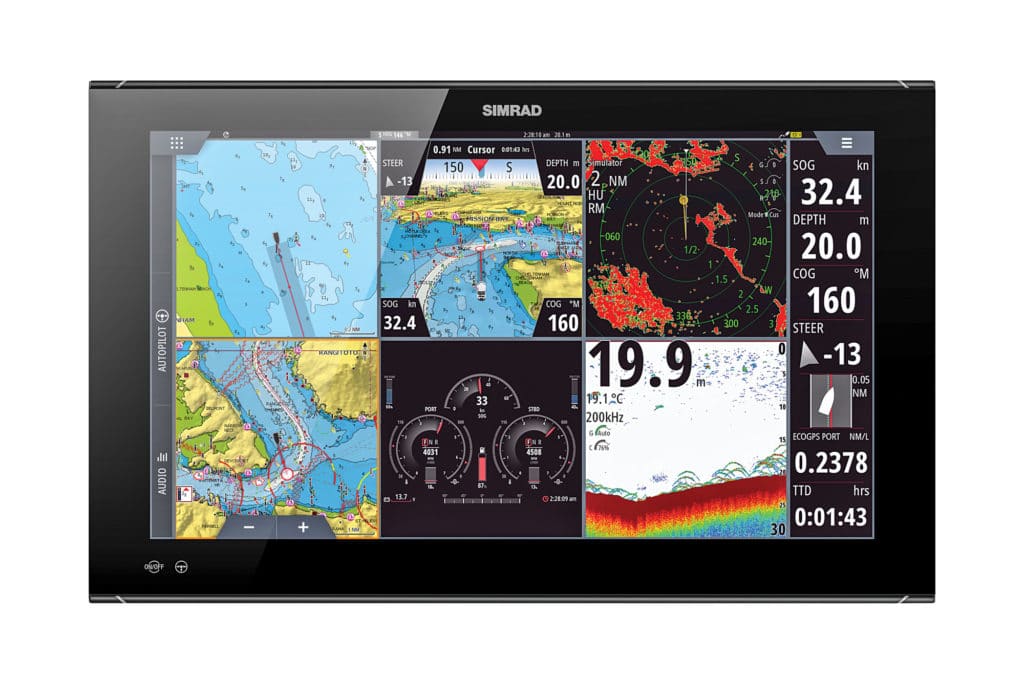
Multifunction displays and marinized computers are fast at first, but layers of software and firmware updates can deposit speed-sucking e-sediment, and newly networked equipment can further tax aging processors. Eventually, the best option for this technology involves hitting the refresh button.
If this sounds like your helm, and if you have Simrad equipment, then the NSO Evo3S is worth a look.
Simrad’s NSO Evo3S display (read: a marinized display with a built-in black-box processor) shares a familiar moniker that adds a significantly faster, six-core processor to its predecessor model. The updates make the NSO Evo3S operating system, application-specific software and networked hardware perform better, while delivering future-proofing for upcoming software updates and hardware.
Simrad’s older-generation NSO Evo3 display and the new flagship NSO Evo3S display share identical platforms, operating systems and touchscreen-only user interfaces. Both systems also have the same screen technology, which includes optical bonding to combat fogging, as well as in-plane switching to deliver wide-angle viewing. Both units further share identical networking capabilities. The NSO Evo3S display is available in 16- ($6,999), 19- ($8,799) and 24-inch ($10,999) screen sizes.
The differences between these two displays reside under the bonnet. “The NSO Evo3S has a next-generation processor,” says Stephen Thomas, Simrad’s executive vice president. “It’s taken the [NSO Evo3′s] display and made it a lot faster.”
Thomas and Greig Keesing, Simrad’s product manager of displays, say the NSO Evo3S upgrades are thanks to the i.MX 8 processor, which is the successor to the i.MX 6 chipset that served as the NSO Evo3′s muscle.
“The i.MX 6 is a four-core processor, while the i.MX 8 is a six-core chip,” Keesing says. “The i.MX 8 has four standard-speed cores and two really fast cores. It’s two to three times faster than the i.MX 6, depending on what you’re doing.”
The system deploys its standard-speed cores first because they consume less power and generate less heat. The system reserves its high-speed cores for graphically intensive applications, such as rendering data from a downstream Simrad StructureScan 3D sonar. “It’s a tangible difference in speed,” Keesing says.
For example, Keesing says, the i.MX 8-equipped NSO Evo3S is significantly faster at commanding a yacht’s digital-switching system, and it’s twice as fast at facilitating page transitions. Additionally, switching between panels is smoother.
“The idea is that you can run the entire boat off of one display,” Keesing says. “The NSO Evo3S improves a user’s experience with the overall ecosystem” of networked marine electronics, including thermal-imaging cameras, radar, sonar and digital-switching systems.
NSO Evo3S displays are bereft of hard buttons and knobs, so Simrad sells OP50 remote controls—either separately or as part of a system pack that includes an MI10 dual-payload micro-SD card reader. The system packs also include external GPS antennas because NSO Evo3S displays, and the NSO Evo3S marine processors, ship without an embedded GPS receiver (they’re typically installed in areas that yield poor reception).
In addition to the NSO Evo3S, Simrad also released its black-box NSO Evo3S Marine Processor (starting at $4,499), which has dual i.MX 8 processors.
“MPUs are like having two MFDs in one box,” Keesing says. “A customer could install two NSO Evo3Ss or one NSO Evo3S MPU and two monitors.”
Based on Simrad’s pricing, customers can buy a single 24-inch NSO Evo3S display for the same price as an NSO Evo3S MPU that comes bundled with dual 19-inch Simrad-branded touchscreen displays.
“Some owners run three displays on their helm—two that connect to an NSO evo3S MPU and a third that connects to a separate [PC-based] system,” Keesing says, noting that this setup allows the NSO Evo3 MPU to be physically installed with other onboard black boxes.
As for how many NSO Evo3S displays or NSO Evo3 MPU-powered monitors can be installed aboard a single yacht, Keesing and Thomas say there’s no real limitation, aside from the physical size of the yacht’s helm. An owner of a 70-footer might spec two 19-inch displays at the helm and another one or two 16-inch screens on the flybridge, while the owner of a 90-footer might opt for three displays at the helm and two screens on the flybridge.
Redundancy is another consideration. While a single NSO Evo3S MPU can drive two monitors, the whole boat could go dark should this lone black-box computer fail. On the other hand, if an NSO Evo3S display fails, then the operator can just switch to using a different unit.
“If there are no financial restraints, MFDs would be the option that I’d go for,” Keesing says.
So if you’re running legacy Simrad MFDs or black-box-driven displays—or if you have NSO Evo3 displays and want a speed boost—NSO Evo3S displays and/or NSO Evo3S MPUs could be a great upgrade. Neither system flinches at fast page transitions, nor will they balk at managing a busy digital-switching system or graphically rendering complex sonar data that can help you hook a pelagic prize.









